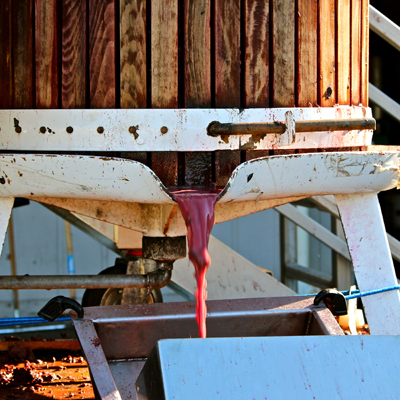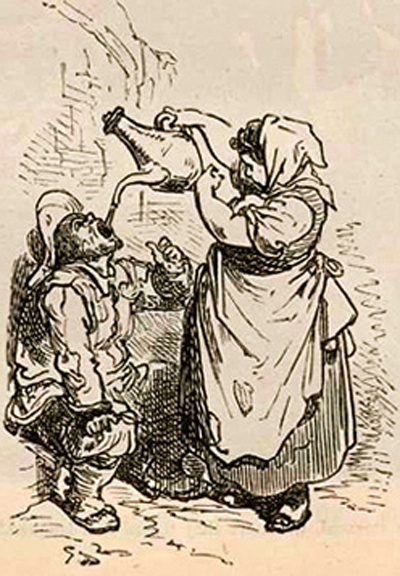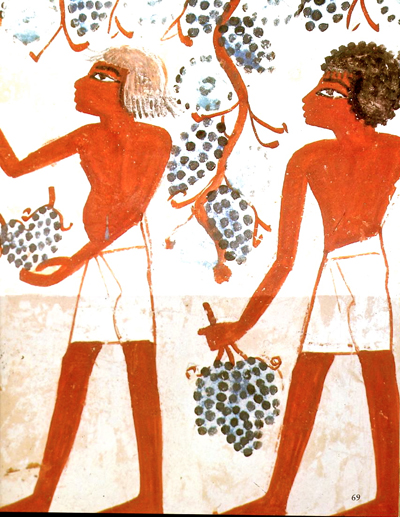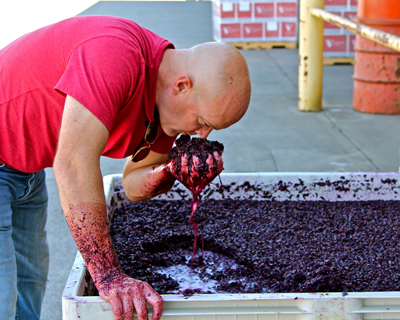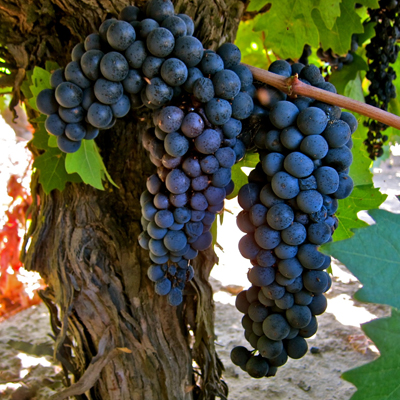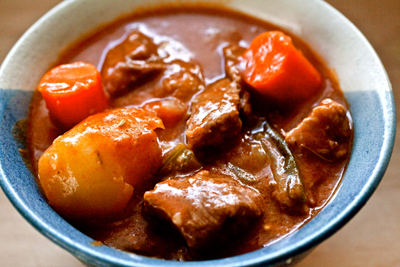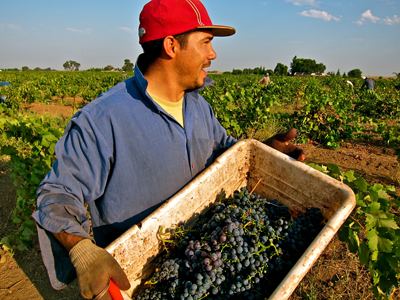Letters from Lodi
An insightful and objective look at viticulture and winemaking from the Lodi
Appellation and the growers and vintners behind these crafts. Told from the
perspective of multi-award winning wine journalist, Randy Caparoso.
Ancient winemaking, taste of a place, and luscious Zinfandel beef stew
This wood basket press, utilized by Lodi's McCay Cellars, is of the same basic design used by winemakers for nearly 1500 years
There is a memorable story in Cervantes' Don Quixote, told by the character of the faithful Sancho Panza, concerning the great wine connoisseurs in his family; particularly, two on his father's side who were once challenged to identify an anonymous wine from a barrel.
The first one brought the wine to the tip of his tongue, and declared the flavor of iron. The second one just needed to pass it under his nose before declaring a stronger flavor of cordovan leather. The owner of the wine protested, however, saying his wine was perfectly clean, with no trace of iron or leather; but later, the men find, at the bottom of the barrel of the wine in question, there was a lost key made of iron attached to a cord of leather.
Sancho Panza in Don Quixote
The story of these men from La Mancha took place at the start of the 1600s, during the same period of time Cervantes wrote his historic book (the first long novel ever published, as it were). Sometimes we forget how old the fine arts – such as literature, wine judging, and artisanal winemaking – really are.
When you walk through a typical winery today and see all the towering gleaming, high-tech stainless steel fermentation tanks, wine presses and destemmer/crushers, you can't help but wonder how wine was made, say, 2000 years ago without the basic equipment. Something miraculous may have happened at the wedding at Cana, but was the wine of actual decent quality?
Still, logic tells us that good, even great, wine was probably being made even back then: why else would multiple cultures continue to advance the art of viticulture and fermentation all these centuries, if there wasn't a delicious liquid reward?
The art of winemaking, in fact, goes back far longer than 2000 years. Archeologists have found evidence of it in excavated shards and stones dating back as far as 7000 BC, in places like present-day Iran, Georgia and Armenia.
Of course, we know that in ancient Egypt wine was both an everyday and ceremonial beverage. The Jewish people had their kosher wine all during Old Testament times; and wine was so important in ancient Greece and Rome that it was worshipped through the gods, Dionysus and Bacchus.
So how in the world was good wine made before modern day technology? Simple. In any kind of container, you crush the grapes to allow the skins to come in contact with the pulp, and the wine begins to ferment – that is, grape sugars are converted into alcohol – by the action of the yeast (Saccharomyces cerevisiae) found naturally on the skins of the grapes. Assembly required, but all tools and batteries included!
Modern day wineries utilize ingenious machinery to remove stems from grapes prior to fermentation in order to avoid the bitter sensations that can be imparted by stems. Ancient people didn't have that luxury, and so they fermented with the stems still attached to the grapes. But because they also crushed the grapes in the gentlest way possible – with their feet – they didn't mash up the stems and release an excess of nasty tannins into the fermenting wine.
Ancient Egyptian grape harvest
In fact, certain wines (like Portugal's Vintage Port) are still foot-tread (often, stems and all), because not only is this the gentlest way to crush grapes, but also because it is considered the best way to extract the most intense flavor. There are numerous artisanal wineries in both Europe and the U.S. that still do a little bit of foot crushing – the only reason why it isn't done more is because of the obvious cost and bother, not because it doesn't make better wine.
Today we also have jillion-dollar contraptions to press out wine soaked into skins after fermentation is completed. In ancient times pressing was also done by foot; although Egyptians devised cloth bags, and by the Middle Ages Europeans were already using the type of wooden basket presses still commonly found in wineries today.
It was observed long ago that wine quality could be further improved through the slow oxidative process of wood barrel aging. Barrel aging is a practice that dates as far back as 350 BC: there is evidence that the Celts were the first to craft large, rounded, sturdy aging vessels from trees like white oak. Even then, the techniques used by barrel makers were hardly revolutionary – long before, the ancient Egyptians and Phoenicians had developed methods of precision cutting and bending of wood staves to build their sailing ships. We also know that the Greeks and Romans graduated from storing wines in large vases (Amphorae sealed with olive oil or pine resin) to wooden wine barrels by the third century AD (probably as a result of contact with Celts in Gaul).
Ergo: ancient people made perfectly delicious wine, thank you. In fact, here in Lodi there is a small group of winemakers who have recently come together for the express purpose of producing wines that, as much as possible, harken back to the days when not much was done to wine beyond crushing, fermenting and aging. They've named their project Lodi Native, and in both 2012 and the most recent 2013 vintages they have produced Lodi grown Zinfandel in this fashion:
• From single "old vine" vineyards (planted prior to 1962, or as long ago as the 1800s).
• Fermented completed with native yeast (that is, not inoculated with laboratory developed yeasts, which is how more than 99.9% of today's wines are made).
• Fermented with zero addition of oak or tannin adjuncts; no acidification (or de-acidification); no addition of water or other de-alcoholizing measures; and no use of concentrate or any other non-natural amendments.
• No use of new oak, innerstaves, oak chips, or anything else that adds "oak flavor" without actually contributing to the aging process (the original purpose of barrel aging).
Michael McCay with native yeast fermented Zinfandel
While falling short of calling for foot treading, by limiting themselves by such minimalist protocols the Lodi Native winemakers hope to achieve this specific goal: to produce Zinfandels with maximum amounts of the flavor and characteristics natural to the vineyards from which they are sourced. They are not afraid to employ low-intervention methodology because they know that perfectly fine wine was made that way long before modern day technology, tricks or shortcuts.
Contemporary winemakers, of course, utilize the many techniques at their disposal in order to achieve a specific taste or style that consumers can consistently identify. This is what "branding" is all about: if consumers can depend upon a consistent brand taste – year after year, bottle after bottle – they are more likely to keep buying that brand.
The Lodi Native group is to be commended because they are deliberately eschewing their respective brand identities in order to produce wines showcasing vineyards – grapes, not winemaking prowess or ego. They are also banking on this basic premise: that the more you "add" to a wine – be it a yeast selected to achieve a certain taste, or a new barrel that can bury natural fruit flavors under an oaky veneer – the less you taste of a place.
Soucie Vineyard Zinfandel
These winemakers, as it were, include Ryan Sherman of Fields Family Wines; Layne Montgomery of m2Wines; Tim Holdener of Macchia Wines; Todd Maley and Chad Joseph of Maley Brothers; Michael McCay of McCay Cellars; and Stuart Spencer of St. Amant Winery.
Among the 2012 Lodi Native Zinfandels that consumers will be able to try upon their release in Spring 2014 will be a Zinfandel grown by Soucie Vineyard, vinified by m2's Layne Montgomery. But even done in m2's usual style, Soucie grown Zinfandels have always been among the most terroir driven wines – that is, tasting strongly of a "place" – produced in California. Year after year, bottling after bottling, m2's Soucie grown Zinfandel always seem to have a taste that Montgomery calls the "Soucie funk" – aromas and flavors that at various stages suggest mushrooms, organic compost, and even "onions cooked in stew," on top of the berry jam tastes typical of the grape. Some wines don't need "natural" handling to taste natural.
But wines like the 2011 m2 Soucie Vineyard Lodi Zinfandel ($28) are precisely the type of wines – rich yet round, smacking of as much earthiness as fruit – that seem to epitomize the warm, cozy feeling of Autumn. It's also the kind of wine that makes you crave warm comforting dishes like Louisiana style red beans and rice, or Mexican machaca (shredded beef)…
Zinfandel beef stew
Zinfandel beef stew
But perhaps even better, a simple yet luscious tomato, carrot and beef studded stew is practically perfection with Zinfandels tasting strongly of earthy, practically primal sensations. Here's a satisfying, zin-friendly recipe:
2 lbs. lean stewing beef, cut into 1-inch cubes
½ cup flour
¼ cup canola oil
2 medium sized sweet onions, wedged
1 clove garlic, pressed
5 cups water
2 bay leaves, broken in half
½ cup red Zinfandel
2 tsp. salt (or to taste)
¼ tsp. black pepper
2 cans (8 oz.) tomato sauce
1 can (13.5 oz.) whole or stewed tomatoes
4 carrots, about ¾ inch chunks
4 potatoes, pared and quartered
1 cup sliced celery
Dredge beef in flour; brown lightly on all sides in hot oil. Add onions and garlic; brown lightly. Add water and bay leaves; simmer 1½ hours, or until beef is tender. Add remaining ingredients; simmer additional 30-60 minutes, or until vegetables are tender. If desired, thicken stew with flour water mixture. Serves 6-8, and strongly recommended with steamed white Japanese rice.
Dogtown Vineyard Zinfandel havest (Lodi’s Clements Hills AVA)
